Unit6 Electricity Grammar & Speaking课件(共30张PPT)
文档属性
| 名称 | Unit6 Electricity Grammar & Speaking课件(共30张PPT) | 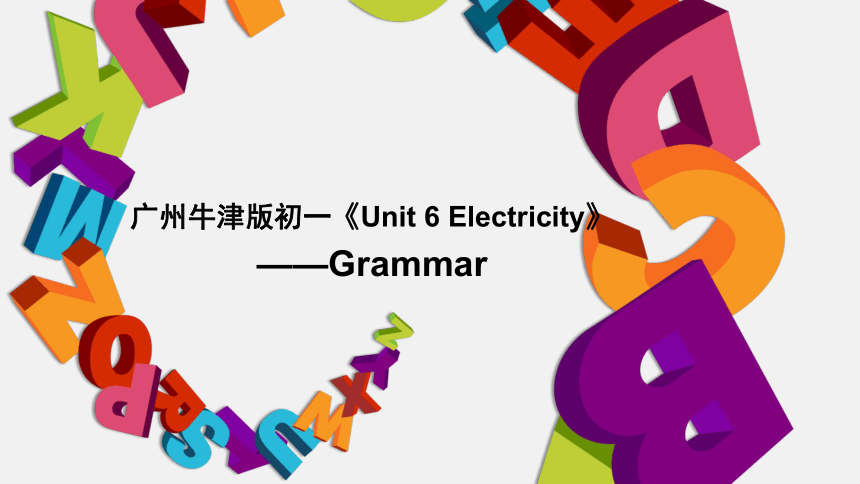 | |
| 格式 | pptx | ||
| 文件大小 | 18.3MB | ||
| 资源类型 | 教案 | ||
| 版本资源 | 牛津深圳版 | ||
| 科目 | 英语 | ||
| 更新时间 | 2022-03-04 20:59:35 | ||
图片预览

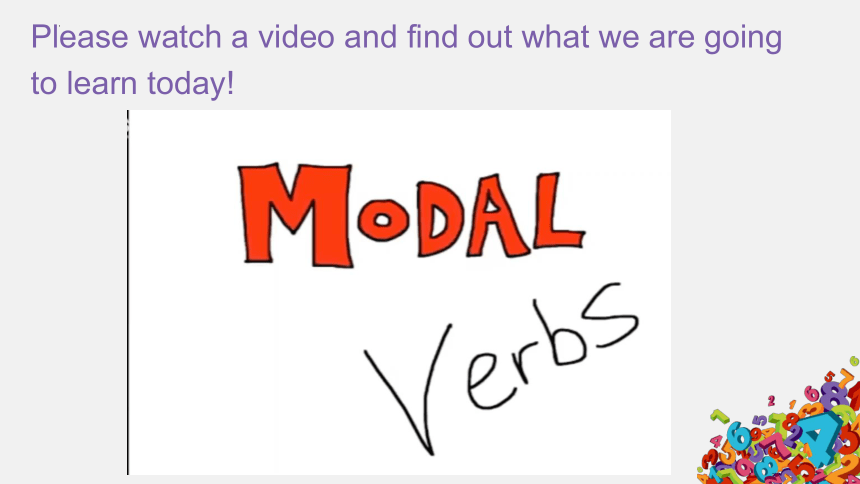
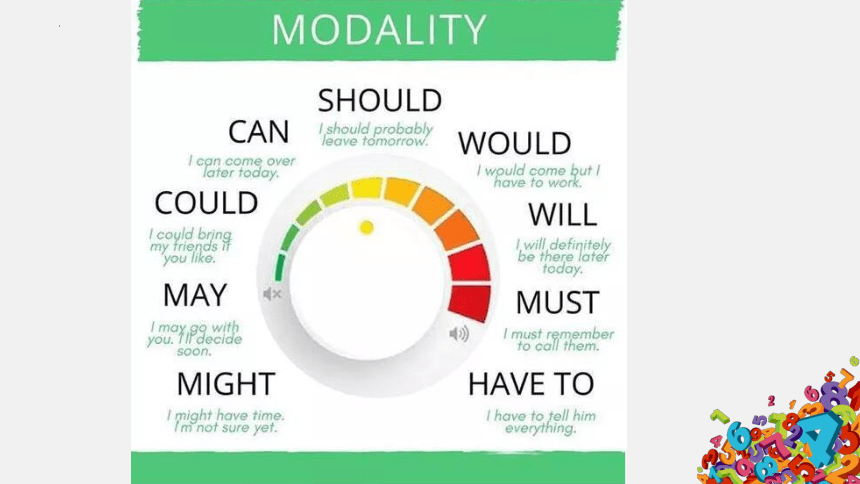
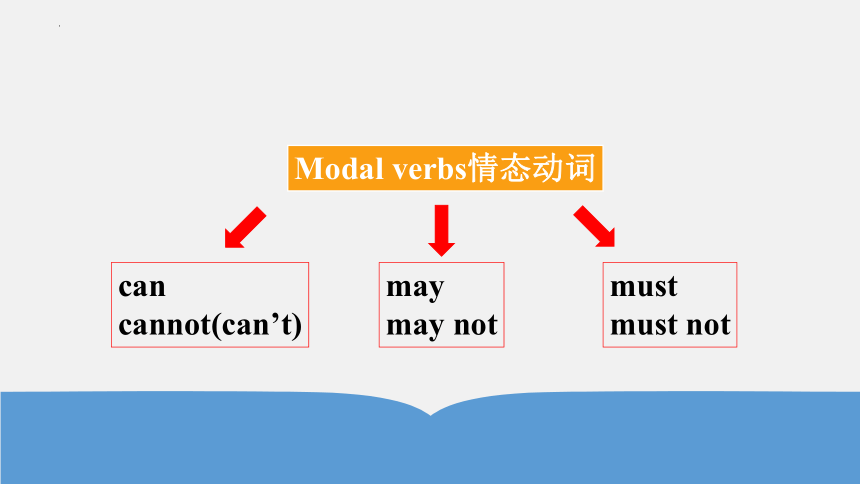
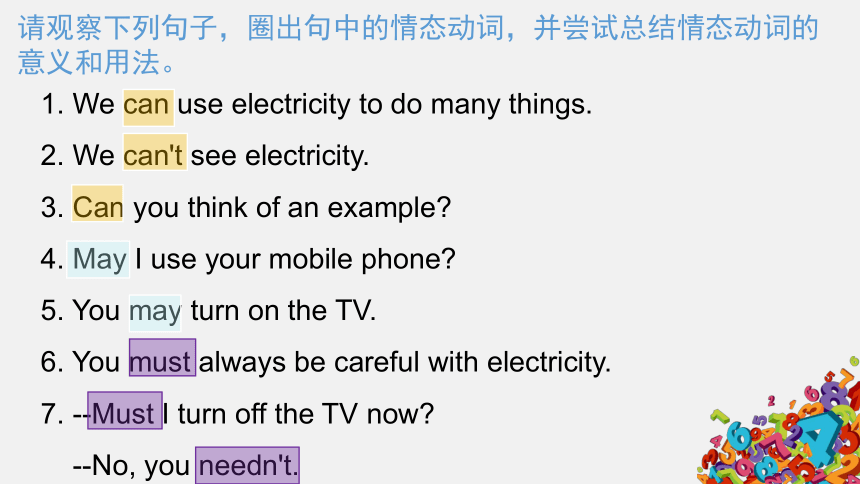
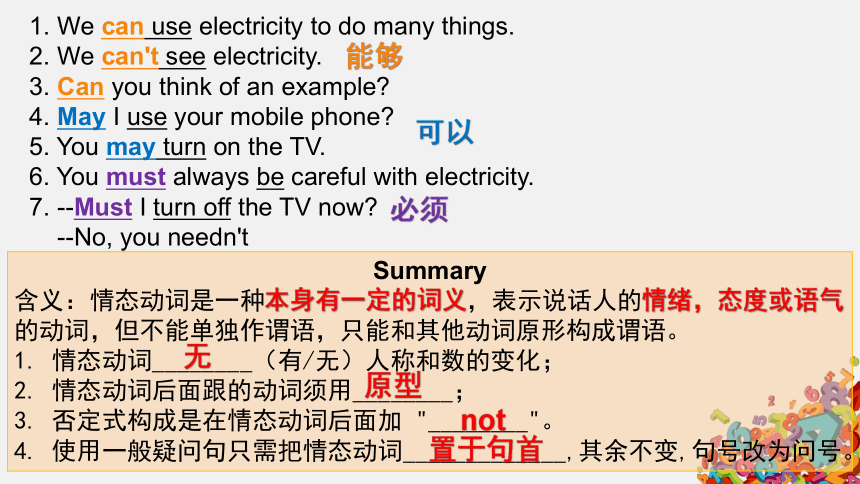
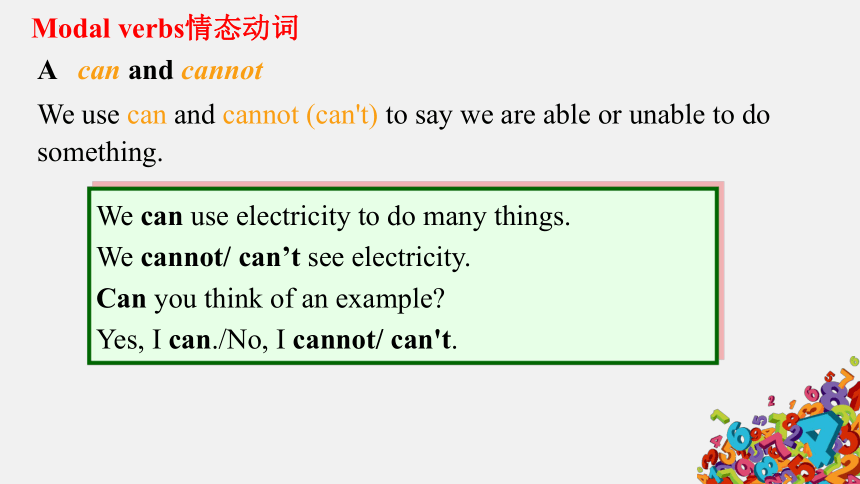
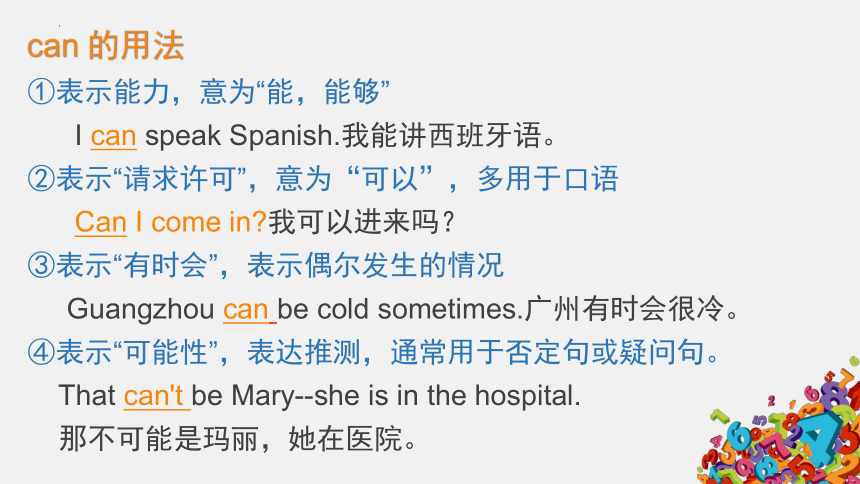
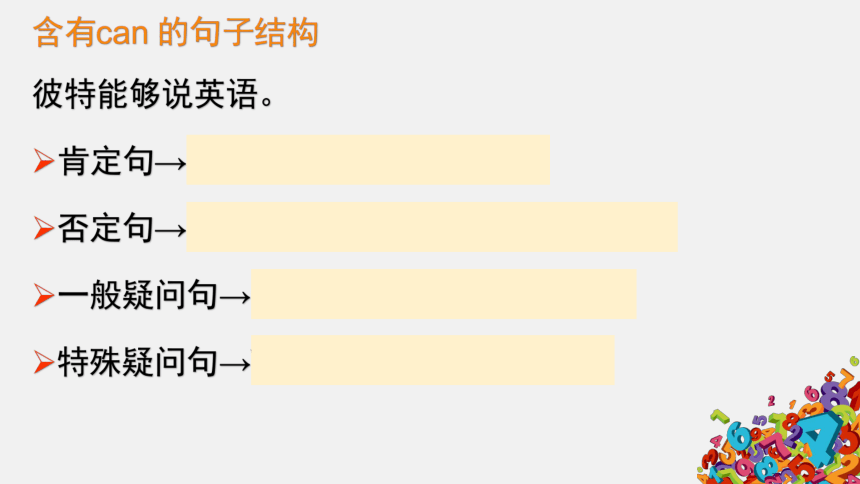
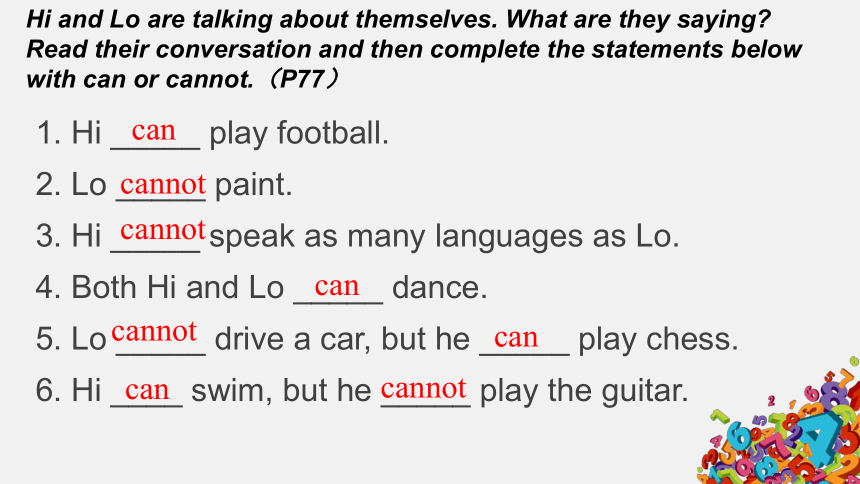
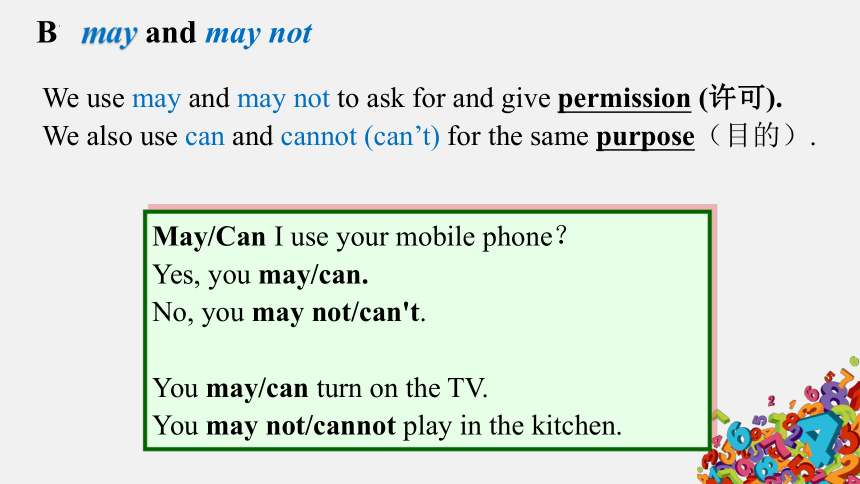
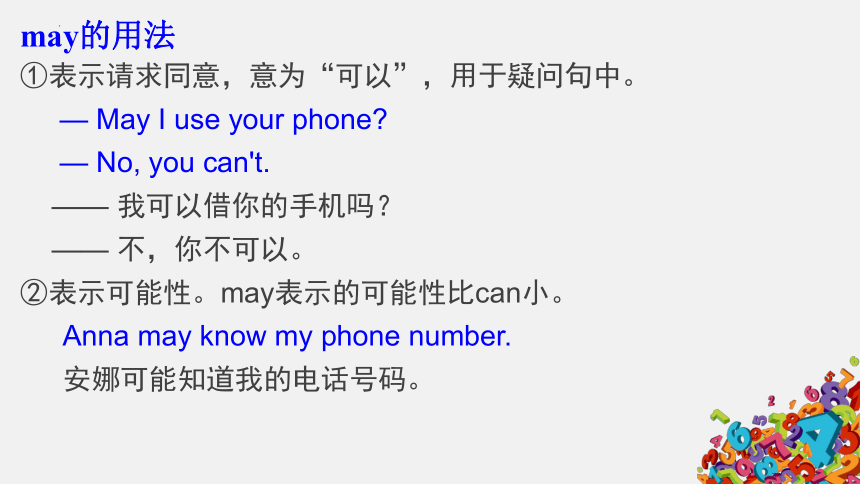
文档简介
(共30张PPT)
广州牛津版初一《Unit 6 Electricity》
——Grammar
Please watch a video and find out what we are going to learn today!
Modal verbs情态动词
can
cannot(can’t)
may
may not
must
must not
请观察下列句子,圈出句中的情态动词,并尝试总结情态动词的意义和用法。
1. We can use electricity to do many things.
2. We can't see electricity.
3. Can you think of an example
4. May I use your mobile phone
5. You may turn on the TV.
6. You must always be careful with electricity.
7. --Must I turn off the TV now
--No, you needn't.
1. We can use electricity to do many things.
2. We can't see electricity.
3. Can you think of an example
4. May I use your mobile phone
5. You may turn on the TV.
6. You must always be careful with electricity.
7. --Must I turn off the TV now
--No, you needn't
Summary
含义:情态动词是一种本身有一定的词义,表示说话人的情绪,态度或语气的动词,但不能单独作谓语,只能和其他动词原形构成谓语。
1. 情态动词________(有/无)人称和数的变化;
2. 情态动词后面跟的动词须用________;
3. 否定式构成是在情态动词后面加 "________"。
4. 使用一般疑问句只需把情态动词_____________,其余不变,句号改为问号。
无
原型
not
能够
可以
必须
置于句首
A can and cannot
We can use electricity to do many things.
We cannot/ can’t see electricity.
Can you think of an example
Yes, I can./No, I cannot/ can't.
Modal verbs情态动词
We use can and cannot (can't) to say we are able or unable to do something.
can 的用法
①表示能力,意为“能,能够”
I can speak Spanish.我能讲西班牙语。
②表示“请求许可”,意为“可以”,多用于口语
Can I come in 我可以进来吗?
③表示“有时会”,表示偶尔发生的情况
Guangzhou can be cold sometimes.广州有时会很冷。
④表示“可能性”,表达推测,通常用于否定句或疑问句。
That can't be Mary--she is in the hospital.
那不可能是玛丽,她在医院。
彼特能够说英语。
肯定句→Peter can speak English.
否定句→Peter can’t/cannot speak English.
一般疑问句→Can Peter speak English
特殊疑问句→What can Peter speak
含有can 的句子结构
Hi and Lo are talking about themselves. What are they saying Read their conversation and then complete the statements below with can or cannot.(P77)
1. Hi _____ play football.
2. Lo _____ paint.
3. Hi _____ speak as many languages as Lo.
4. Both Hi and Lo _____ dance.
5. Lo _____ drive a car, but he _____ play chess.
6. Hi ____ swim, but he _____ play the guitar.
can
can
can
can
cannot
cannot
cannot
cannot
May/Can I use your mobile phone?
Yes, you may/can.
No, you may not/can't.
You may/can turn on the TV.
You may not/cannot play in the kitchen.
B may and may not
We use may and may not to ask for and give permission (许可). We also use can and cannot (can’t) for the same purpose(目的).
①表示请求同意,意为“可以”,用于疑问句中。
— May I use your phone
— No, you can't.
—— 我可以借你的手机吗?
—— 不,你不可以。
②表示可能性。may表示的可能性比can小。
Anna may know my phone number.
安娜可能知道我的电话号码。
may的用法
注意:may构成的一般疑问句及其回答形式如下:
我可以在这里拍照吗?
May I take photos here
— (肯定回答) Yes, you may / can.
— (否定回答) No, you may not / can’t /mustn’t.
(注:mustn’t 的语气最强,表示禁止)
Daisy is not feeling well today. Benny is at home with her. Read their conversation below. Fill in the blanks with may or can.
Benny: How are you feeling, Daisy
Daisy: Not very well.
Benny: _________ I get you a chair
Daisy: Yes, thanks.
Benny: I’m going out. _____ I borrow your bicycle,
Daisy
Daisy: Yes, you may. Before you go to meet your friends,
can you come and see the doctor with me
Benny: Yes. I ____. ______ I carry your bag for you
Daisy: Yes, that’s very kind of you, Benny.
I’m ready to go.________ you open the door for me
Benny: Yes, I can.
Daisy: Thanks.
May
May
Can
Can
May/Can
C must and must not
You must not/mustn't do that, Benny!
We must always be careful with electricity.
They must not/mustn't play near the heater.
We use must and must not/mustn't to tell people what to do or what not to do.
What do these signs mean
You mustn’t smoke here.
You mustn’t fish here.
You mustn’t use your mobile phone here.
You mustn’t take photos.
①表示规定,命令,强制,意为“必须;一定”,多指现在或将来的情况,指说话人的主观语气,其否定形式表示”禁止“。
如:
你必须先做作业。
You must do your homework first.
你不许在这里吸烟。
You mustn’t smoke here.
must的用法
②表示猜测,意为“一定是”,“准是”,常指有根据的,比较有把握的推测,仅用于肯定句。
Jack and Dick must be twins. They look so much alike!
杰克和迪克准时双胞胎,他们长得太像了。
注意:
must 构成的一般疑问句及其回答形式如下:
我必须现在交作业吗?
— Must I hand in the homework now
— (肯定回答) Yes, you must.
— (否定回答) No, you needn’t./No, you don't have to.
辨析must和have to
意义 形式 用法
must “必须;一定” 只有must 强调客观上必须做某事
have to “ 不得不;必须” have有各种时态和数 强调主观上不得不做某事
辨析must和have to
Daisy saw a doctor. The doctor told her what to do and what not to do. Help her write down the doctor’s instructions.
drink more water go to bed early
eat cold food share cups with others
go out alone take the medicine on time
I must drink more water.
______________________________
______________________________
I must not _____________________
______________________________
______________________________
I must go to bed early.
I must take the medicine on time.
eat cold food.
I must not go out alone.
I must not share cups with others.
情态动词 用法 否定形式及含义 疑问句及回答 共同点
can 表示具有某种能力,意为“能”,非正式场合也可以表示许可,相当于“may“ cannot/can't 不能 --Can... --Yes,...can. --No,...can't. 情态动词后要使用动词原形
may 表示请求,允许,意为“可以” may not 不可以 --May... --Yes,...may. --No,...may not/ can't/mustn't. must 用来指定规则或者发出命令,意为”必须“ must not/mustn't 禁止 --Must... --Yes,...must. --No,...needn't/don't have to. B Speak up
Johnny's father is talking to Johnny about safety at home. Work in pairs. S1 is Johnny. S2 is Dad. Follow the Example.
cover the meat
lock the door
switch off the electricity
test the water
tidy up
______change the bulb
Example:
S1: May I change the bulb
S2: No, you may not. You must switch off the
electricity. Then you may change the bulb.
Work in pairs to make a dialogue!
______ put the meat in the fridge
S1: May I put the meat in the fridge
S2: No, you many not. You must cover the meat. Then you may put the meat in the fridge.
______ go to bed
S1: May I go the bed
S2: No, you may not. You must lock the door. Then you may go to bed.
______ take a bath now
S1: May I take a bath now
S2: No, you many not. You must test the water. Then you may take a bath.
______ go out now
S1: May I go out now
S2: No, you many not. You must tidy up. Then you may go out.
“双减”背景下,作业如何减负?
Homework
书面作业(选做)
创新探究性作业(选做)
1. 完成《双语报》N2版Grammar跟踪练习。
2. 完成《双语报》N4版第四课时Grammar练习。
3. 完成阳光学评P103 Grammar部分练习。
4.总结这节语法课仍然存在疑惑的点,整理成错题本。
1. 小组合作,搜集身边含有情态动词的路标、指示牌或者标志。
2.你认为学校的规章制度应该有哪些?用上情态动词将你的想法写下来。
广州牛津版初一《Unit 6 Electricity》
——Grammar
Please watch a video and find out what we are going to learn today!
Modal verbs情态动词
can
cannot(can’t)
may
may not
must
must not
请观察下列句子,圈出句中的情态动词,并尝试总结情态动词的意义和用法。
1. We can use electricity to do many things.
2. We can't see electricity.
3. Can you think of an example
4. May I use your mobile phone
5. You may turn on the TV.
6. You must always be careful with electricity.
7. --Must I turn off the TV now
--No, you needn't.
1. We can use electricity to do many things.
2. We can't see electricity.
3. Can you think of an example
4. May I use your mobile phone
5. You may turn on the TV.
6. You must always be careful with electricity.
7. --Must I turn off the TV now
--No, you needn't
Summary
含义:情态动词是一种本身有一定的词义,表示说话人的情绪,态度或语气的动词,但不能单独作谓语,只能和其他动词原形构成谓语。
1. 情态动词________(有/无)人称和数的变化;
2. 情态动词后面跟的动词须用________;
3. 否定式构成是在情态动词后面加 "________"。
4. 使用一般疑问句只需把情态动词_____________,其余不变,句号改为问号。
无
原型
not
能够
可以
必须
置于句首
A can and cannot
We can use electricity to do many things.
We cannot/ can’t see electricity.
Can you think of an example
Yes, I can./No, I cannot/ can't.
Modal verbs情态动词
We use can and cannot (can't) to say we are able or unable to do something.
can 的用法
①表示能力,意为“能,能够”
I can speak Spanish.我能讲西班牙语。
②表示“请求许可”,意为“可以”,多用于口语
Can I come in 我可以进来吗?
③表示“有时会”,表示偶尔发生的情况
Guangzhou can be cold sometimes.广州有时会很冷。
④表示“可能性”,表达推测,通常用于否定句或疑问句。
That can't be Mary--she is in the hospital.
那不可能是玛丽,她在医院。
彼特能够说英语。
肯定句→Peter can speak English.
否定句→Peter can’t/cannot speak English.
一般疑问句→Can Peter speak English
特殊疑问句→What can Peter speak
含有can 的句子结构
Hi and Lo are talking about themselves. What are they saying Read their conversation and then complete the statements below with can or cannot.(P77)
1. Hi _____ play football.
2. Lo _____ paint.
3. Hi _____ speak as many languages as Lo.
4. Both Hi and Lo _____ dance.
5. Lo _____ drive a car, but he _____ play chess.
6. Hi ____ swim, but he _____ play the guitar.
can
can
can
can
cannot
cannot
cannot
cannot
May/Can I use your mobile phone?
Yes, you may/can.
No, you may not/can't.
You may/can turn on the TV.
You may not/cannot play in the kitchen.
B may and may not
We use may and may not to ask for and give permission (许可). We also use can and cannot (can’t) for the same purpose(目的).
①表示请求同意,意为“可以”,用于疑问句中。
— May I use your phone
— No, you can't.
—— 我可以借你的手机吗?
—— 不,你不可以。
②表示可能性。may表示的可能性比can小。
Anna may know my phone number.
安娜可能知道我的电话号码。
may的用法
注意:may构成的一般疑问句及其回答形式如下:
我可以在这里拍照吗?
May I take photos here
— (肯定回答) Yes, you may / can.
— (否定回答) No, you may not / can’t /mustn’t.
(注:mustn’t 的语气最强,表示禁止)
Daisy is not feeling well today. Benny is at home with her. Read their conversation below. Fill in the blanks with may or can.
Benny: How are you feeling, Daisy
Daisy: Not very well.
Benny: _________ I get you a chair
Daisy: Yes, thanks.
Benny: I’m going out. _____ I borrow your bicycle,
Daisy
Daisy: Yes, you may. Before you go to meet your friends,
can you come and see the doctor with me
Benny: Yes. I ____. ______ I carry your bag for you
Daisy: Yes, that’s very kind of you, Benny.
I’m ready to go.________ you open the door for me
Benny: Yes, I can.
Daisy: Thanks.
May
May
Can
Can
May/Can
C must and must not
You must not/mustn't do that, Benny!
We must always be careful with electricity.
They must not/mustn't play near the heater.
We use must and must not/mustn't to tell people what to do or what not to do.
What do these signs mean
You mustn’t smoke here.
You mustn’t fish here.
You mustn’t use your mobile phone here.
You mustn’t take photos.
①表示规定,命令,强制,意为“必须;一定”,多指现在或将来的情况,指说话人的主观语气,其否定形式表示”禁止“。
如:
你必须先做作业。
You must do your homework first.
你不许在这里吸烟。
You mustn’t smoke here.
must的用法
②表示猜测,意为“一定是”,“准是”,常指有根据的,比较有把握的推测,仅用于肯定句。
Jack and Dick must be twins. They look so much alike!
杰克和迪克准时双胞胎,他们长得太像了。
注意:
must 构成的一般疑问句及其回答形式如下:
我必须现在交作业吗?
— Must I hand in the homework now
— (肯定回答) Yes, you must.
— (否定回答) No, you needn’t./No, you don't have to.
辨析must和have to
意义 形式 用法
must “必须;一定” 只有must 强调客观上必须做某事
have to “ 不得不;必须” have有各种时态和数 强调主观上不得不做某事
辨析must和have to
Daisy saw a doctor. The doctor told her what to do and what not to do. Help her write down the doctor’s instructions.
drink more water go to bed early
eat cold food share cups with others
go out alone take the medicine on time
I must drink more water.
______________________________
______________________________
I must not _____________________
______________________________
______________________________
I must go to bed early.
I must take the medicine on time.
eat cold food.
I must not go out alone.
I must not share cups with others.
情态动词 用法 否定形式及含义 疑问句及回答 共同点
can 表示具有某种能力,意为“能”,非正式场合也可以表示许可,相当于“may“ cannot/can't 不能 --Can... --Yes,...can. --No,...can't. 情态动词后要使用动词原形
may 表示请求,允许,意为“可以” may not 不可以 --May... --Yes,...may. --No,...may not/ can't/mustn't. must 用来指定规则或者发出命令,意为”必须“ must not/mustn't 禁止 --Must... --Yes,...must. --No,...needn't/don't have to. B Speak up
Johnny's father is talking to Johnny about safety at home. Work in pairs. S1 is Johnny. S2 is Dad. Follow the Example.
cover the meat
lock the door
switch off the electricity
test the water
tidy up
______change the bulb
Example:
S1: May I change the bulb
S2: No, you may not. You must switch off the
electricity. Then you may change the bulb.
Work in pairs to make a dialogue!
______ put the meat in the fridge
S1: May I put the meat in the fridge
S2: No, you many not. You must cover the meat. Then you may put the meat in the fridge.
______ go to bed
S1: May I go the bed
S2: No, you may not. You must lock the door. Then you may go to bed.
______ take a bath now
S1: May I take a bath now
S2: No, you many not. You must test the water. Then you may take a bath.
______ go out now
S1: May I go out now
S2: No, you many not. You must tidy up. Then you may go out.
“双减”背景下,作业如何减负?
Homework
书面作业(选做)
创新探究性作业(选做)
1. 完成《双语报》N2版Grammar跟踪练习。
2. 完成《双语报》N4版第四课时Grammar练习。
3. 完成阳光学评P103 Grammar部分练习。
4.总结这节语法课仍然存在疑惑的点,整理成错题本。
1. 小组合作,搜集身边含有情态动词的路标、指示牌或者标志。
2.你认为学校的规章制度应该有哪些?用上情态动词将你的想法写下来。
